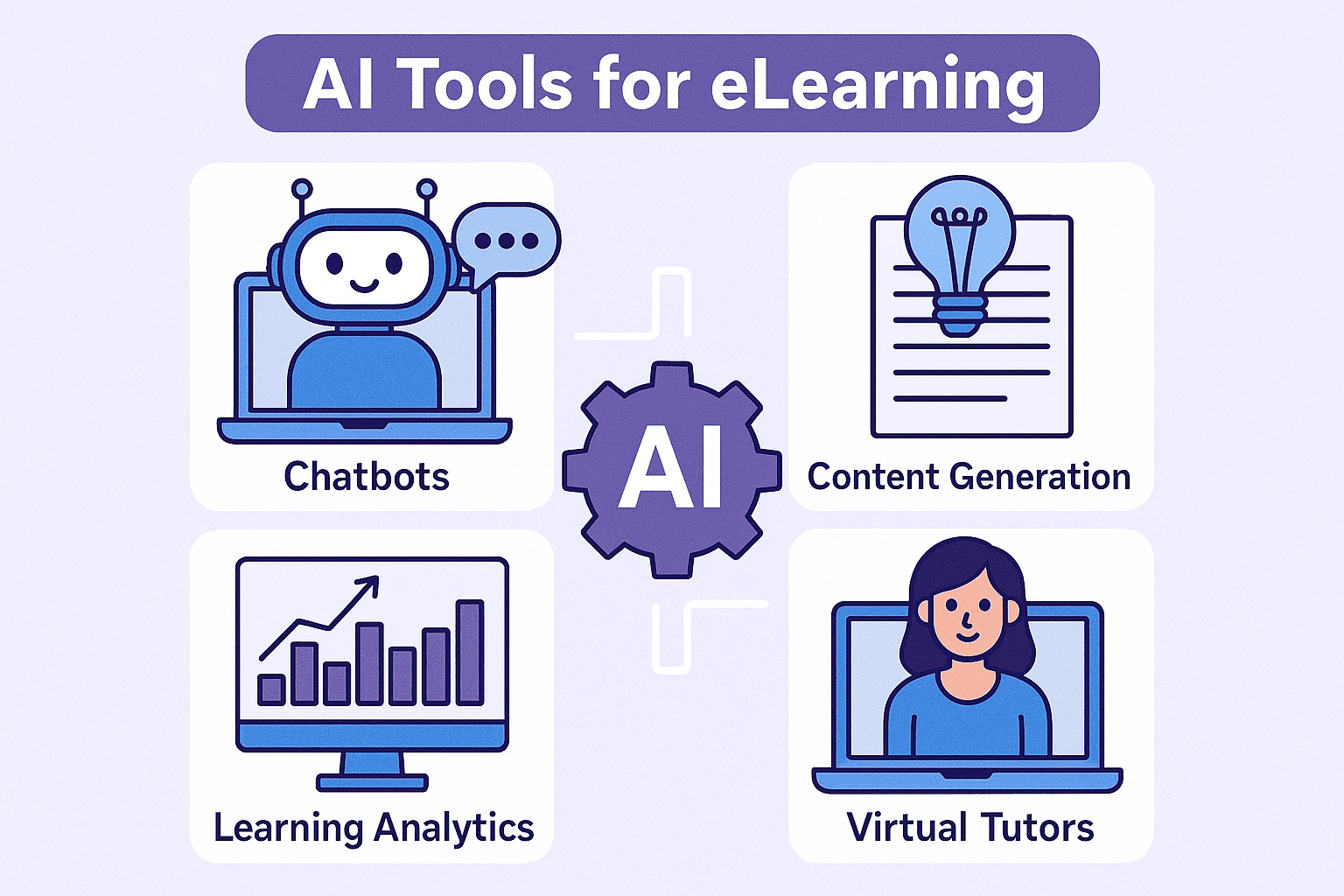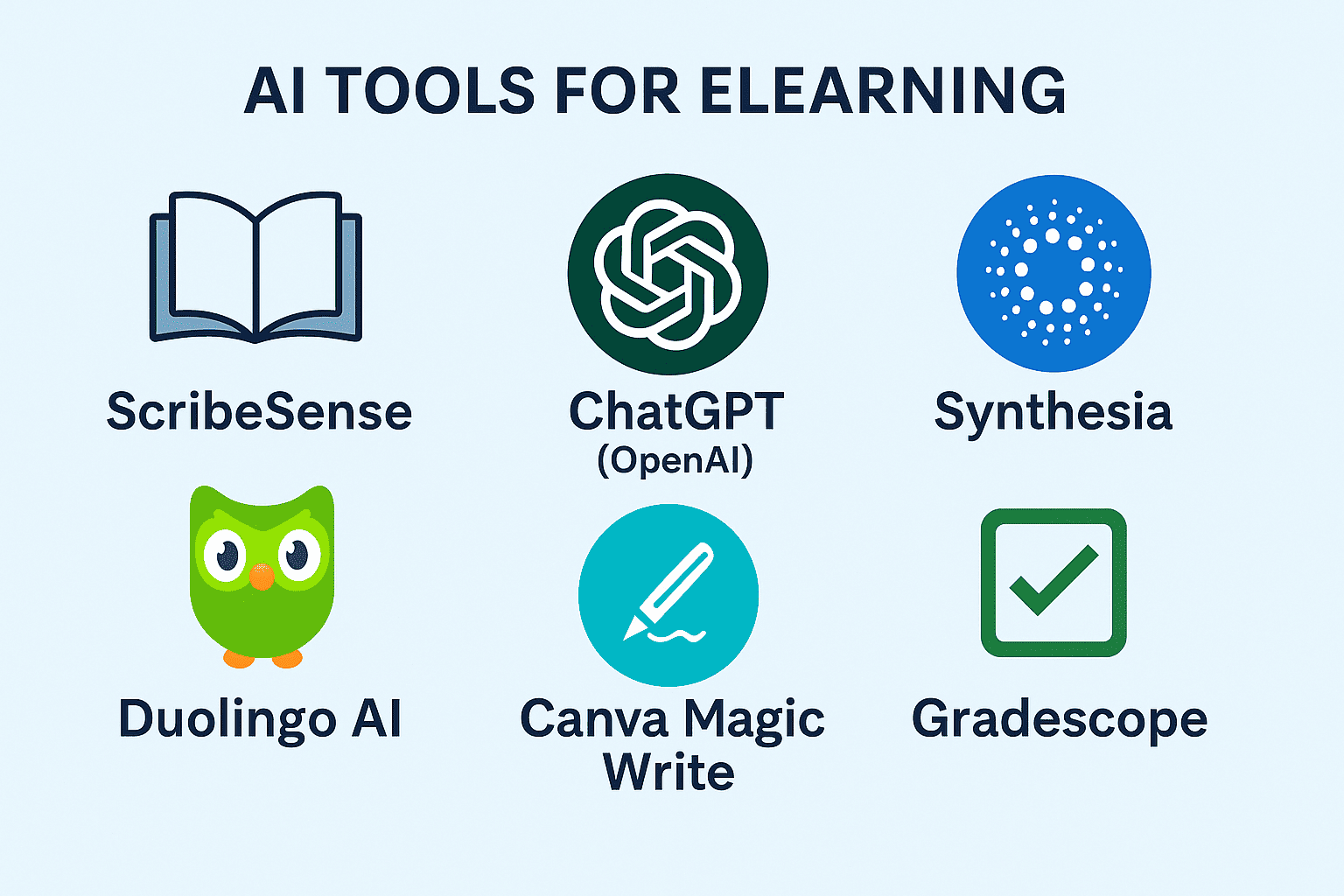Explore the best AI tools for eLearning in 2025. These powerful educational technologies use artificial intelligence to personalize learning, automate content creation, and increase student engagement.
In the ever-evolving landscape of education, digital transformation has taken a major leap with the integration of artificial intelligence (AI). As classrooms become virtual and learners demand personalized experiences, AI tools for eLearning are transforming how content is created, delivered, and consumed. From intelligent tutoring systems to automated content generation, AI enables educators to offer more effective, engaging, and adaptive learning experiences. Whether you’re a teacher, instructional designer, or EdTech entrepreneur, understanding these tools can help you elevate your digital learning solutions.

Table of Contents
What Are AI Tools for eLearning?
AI tools for eLearning are software solutions that use machine learning, natural language processing, and data analytics to enhance digital education. These tools support a wide range of functionalities:
- Personalized Learning: Tailor learning paths based on a student’s behavior and performance.
- Automated Content Creation: Generate quizzes, summaries, lessons, or multimedia presentations.
- Predictive Analytics: Forecast student outcomes, dropout risks, or areas needing support.
- Smart Grading and Assessment: Automate evaluation of assignments and quizzes.
- Virtual Assistants: Provide on-demand help and tutoring.
- Language Translation: Translate course content in multiple languages for diverse learners.
Why Use AI Tools in eLearning?
AI tools bring several benefits to digital learning environments that help educators and learners alike. Here’s why they’re increasingly being adopted:
- Personalized Learning: AI adapts content and learning paths based on each student’s strengths, weaknesses, and pace.
- Automated Tasks: Grading, quiz generation, and content curation are handled by AI, saving time for educators.
- Real-Time Analytics: Educators receive insights into student performance, helping identify gaps early and adjust teaching strategies accordingly.
- Improved Engagement: Tools like chatbots, smart quizzes, and gamification increase student interest and motivation.
- Scalability: Whether you’re teaching 50 or 5,000 students, AI ensures consistent quality and personalized support.
- Accessibility Support: Features such as text-to-speech, captioning, and multilingual support make learning inclusive and accessible for all.
15 AI Tools for eLearning in 2025
| Tool | Ideal For | Key Features |
| ScribeSense | Automating grading | AI-based test scoring and analytics. |
| Knewton | Personalized learning | Adaptive learning paths. |
| Gradescope | Assessment automation | Evaluates written work, MCQs, and coding assignments. |
| Quizgecko | Quiz creation | Automatically builds quizzes from documents or URLs. |
| ChatGPT(OpenAI) | Tutoring and content creation | Answer questions, explain concepts, generate assignments. |
| Otter.ai | Note-taking from lectures | Transcribes spoken content, searchable summaries. |
| Synthesia | AI-generated educational videos | Create avatar-led explainer videos. |
| Speechify | Text-to-speech learning | Reads out text in multiple languages. |
| Kahoot! AI | Game-based learning | AI-curated quizzes and interactive assessments. |
| Duolingo AI | Language education | Smart grammar correction, learning optimization. |
| Edmentum | K-12 curriculum delivery | Real-time learning paths, performance monitoring. |
| Conker AI | Flashcard and quiz generation | Turn notes into study materials automatically. |
| Canva Magic Write | Creating learning visuals | Generate slides, worksheets, and educational graphics. |
| Querium | STEM education support | Offers AI-guided learning in science and mathematics. |
| Century Tech | Learning insights. | Tracks student progress, content suggestions. |

Best Practices for Using AI in eLearning
- Define Clear Objectives: Before implementing any AI tool, identify what you want to achieve, whether it’s automating grading, personalizing instruction, or improving student retention.
- Train Educators and Learners: Provide training for teachers and students to understand how to use AI tools. This builds confidence and ensures the tools are used effectively.
- Ensure Transparency and Ethics: Be transparent about how AI tools work and the data they collect. Always prioritize privacy and follow regulations such as GDPR or FERPA.
- Maintain Human Oversight: AI should support, not replace educators. Keep teachers involved in content creation, feedback, and student interactions.
- Monitor Performance and Gather Feedback: Regularly assess how the AI tools are performing. Use analytics and user feedback to fine-tune their integration.
- Promote Accessibility and Inclusion: Choose tools that accommodate different learning styles, languages, and abilities to ensure no student is left behind.
Practical Applications of AI in Education
- AI enables teachers to create adaptive lesson plans based on student performance data, helping personalize learning experiences for each individual.
- Predictive analytics identify learners at risk of falling behind, allowing for early intervention and additional support.
- AI systems suggest relevant videos, readings, or exercises, streamlining the learning process with curated resources.
- In corporate environments, AI creates customized learning paths aligned with employees’ roles and skill gaps, improving training outcomes.
- Companies benefit from detailed insights through learning analytics that measure knowledge retention and training effectiveness.
- AI empowers independent educators to build courses faster by generating quizzes, summaries, and visual aids automatically.
- AI chatbots and virtual tutors provide around-the-clock support to learners, enhancing engagement and accessibility.
Final Thoughts
AI tools are fundamentally changing how education is created, delivered, and experienced. As digital transformation accelerates, these tools are no longer optional; they are essential for enhancing learning outcomes. By automating administrative tasks, offering adaptive learning, and making education more inclusive, AI equips educators with the ability to focus more on teaching and less on repetitive work.
As we look ahead, the role of AI in learning will only grow. Embracing its potential today means preparing for a smarter, more connected, and more effective education system tomorrow.
FAQs:
What are AI tools for eLearning used for?
AI tools are designed to automate tasks like grading and content creation, provide personalized learning experiences, and support both educators and students in digital learning environments.
Are AI tools suitable for all types of learners?
Yes, most AI tools are built to support diverse learning styles by offering content in multiple formats such as video, text, and audio. They also provide personalized feedback based on performance.
How do AI tools impact teacher-student interaction?
AI tools reduce administrative burdens, allowing teachers to spend more time engaging with students and providing mentorship rather than grading and paperwork.
Can AI tools be used in offline or low-internet settings?
Some tools offer offline features or downloadable content, but most AI tools perform best with stable internet connections.
Will AI replace educators in the future?
No. AI is a support system that enhances the capabilities of educators. The human element empathy, motivation, and creativity remains irreplaceable in education.

